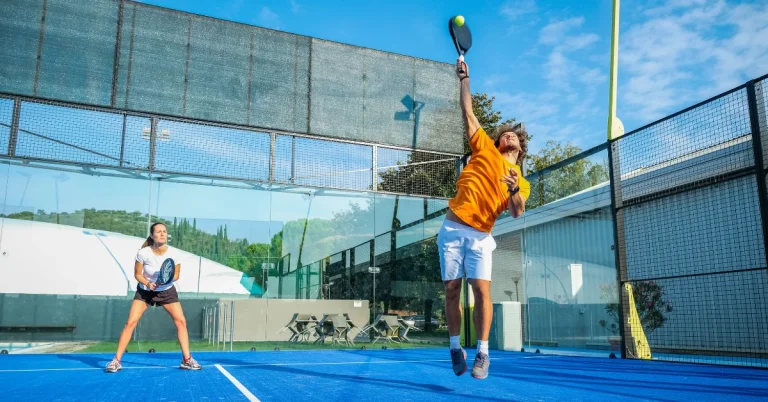Welcome to the Thrilling World of Padel
Embark on a journey into Padel, a sport that seamlessly blends the excitement of tennis and squash. Whether you’re a seasoned player or new to racket sports, grasping the
Rules of Padel is crucial for a rewarding experience. Let’s delve into what makes Padel an enthralling game for players worldwide.
The Padel Court Explained in Detail
Let’s get a closer look at the Padel court, a unique blend of architectural design and functionality. A standard Padel court measures 20 meters in length and 10 meters in width, enclosed by walls. These walls are a mix of materials – typically, the back walls are made of solid concrete or brick, while the side walls are a combination of solid structure and transparent glass or mesh. This blend allows for an interesting dynamic where the ball can be played off these surfaces, adding an exciting layer to the game.One of the most striking features is the use of glass. The transparent sections not only provide spectators with a clear view of the game but also add a tactical element for players. Additionally, the court has openings near the corners, offering strategic play options. The net, splitting the court in half, stands at a height of 88 centimeters at the center and slightly higher at the sides, mirroring the dimensions used in tennis. This setup provides a perfect arena for both power plays and skillful tactics, making every game of Padel a unique challenge and experience.The court’s surface is another crucial aspect. It’s usually covered with artificial turf, which offers better grip and reduces the risk of injuries. The color of the turf varies, but it’s often blue or green, providing a contrast with the yellow Padel balls for optimal visibility. Understanding the court’s dimensions, materials, and layout is essential for both beginners and pros, as it heavily influences gameplay strategy and style.
Scoring in Padel: Similarities to Tennis
Scoring in Padel might feel familiar, mirroring tennis with a progression from love, 15, 30, to 40. Matches are played in sets, each aiming for six games with a potential tie-breaker at 6-6, keeping the game’s pace energetic and engaging.
How to Serve in Padel
The game starts with an underhand serve, a distinctive feature of Padel. The server bounces the ball within their box and strikes it below the waist. The ball must land diagonally in the opposite service box, and just like tennis, a second serve is permitted if the first fails.
The Dynamics of Ball Play
Once the ball is in play, Padel shows its true flair. Players can hit the ball straight over the net or utilize the walls for strategic plays. But remember, the ball is only allowed one bounce on the ground, and a direct wall hit (without a bounce) counts as out. This rule calls for quick thinking and agility.
Points and Outs: Navigating the Scoring Nuances
Understanding how points are scored and what constitutes an ‘out’ is vital in Padel. A point is won when the ball bounces twice in the opponent’s court or if they fail to return it properly. However, the game of Padel offers a unique twist that sets it apart from similar racket sports: players are allowed to play the ball from outside the court. If the ball goes over the side walls but remains within the court limits, players can exit the court to hit the ball back into play. This rule adds an exhilarating and unpredictable element to the game, requiring quick thinking and agility.Be cautious, though: if the ball bounces on your side and then touches the fence or wall, it’s considered out. Similarly, hitting the ball over the fence without it first touching your opponent’s court is also an out. These rules encourage strategic plays and awareness of the court boundaries. Mastering the art of scoring and avoiding outs, including the skillful play of returning balls from outside the court, can significantly elevate your game and make you a formidable opponent in Padel.
The Fun of Doubles
Most Padel games are doubles, making teamwork essential. Effective communication, strategic plays, and understanding your partner’s strengths lead to a more enjoyable and successful game. It’s about synchronization and support in every shot.
The International Padel Federation: Governing the Sport
Padel’s rapid growth and global reach are overseen by the
International Padel Federation (FIP). Founded in 1991, the FIP is dedicated to the promotion and regulation of Padel worldwide. It sets the official rules, organizes international tournaments, and works to include Padel in major sporting events. The FIP plays a pivotal role in uniting Padel communities across different nations, fostering the sport’s development, and elevating its status on the global stage. For detailed information on the official rules, refer to the
Regulations of the Padel Game.
Advanced Techniques: Up Your Game
Ready to enhance your skills? Mastering wall bounces and refining your net play are crucial for advanced Padel. Anticipate the ball’s rebound off the walls and position yourself strategically for volleys. This level of play demands both physical agility and mental acuity.
Padel Etiquette: The Spirit of the Game
Padel is more than a sport; it’s a celebration of fair play and camaraderie. A warm handshake and a respectful attitude towards fellow players underscore the essence of Padel. It’s a game where fun and sportsmanship triumph, regardless of the match’s intensity.
Joining the Padel Community
With these rules and tips in hand, you’re ready to immerse yourself in the Padel community. This sport offers a blend of fitness, strategy, and social interaction. Grab your paddle, team up, and be part of the growing global passion for Padel!
